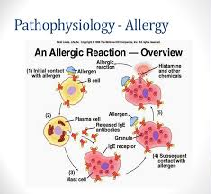Athophysiology of an Allergic Reaction Order Instructions: Briefly discuss the pathophysiology of an allergic reaction brought upon by administering antibiotics to a patient.

Athophysiology of an Allergic Reaction Sample Answer
DYNAMIC OF PRACTICE
An antibiotic reaction occurs soon after one takes the medicine or days after the patient had stopped taking the medicine. This arises because the patient immune system gets sensitive to the medication one takes it, making the patient develop antibiotic reaction the next time they take it. The antibiotics chemical compound combines with the serum proteins forming antigens; the next time one takes the antibiotics, it gives rise to antibodies. This creates immunological conditions. The antigens produce antigen-antibody reaction, releasing histamine and histamine-like substances in the blood stream; which in turn precipitate an alarming shock-like syndrome (McKean, 2012).
Interleukin (IL) 4 and IL 3 play an integral role in initial generation of inflammatory cell responses and the antibiotics. It has also been argued that other chemical substances such as cholinergic substances such as neutral protease, chymase, tryptase, and cytokines mediators activates the complement cascade, the kallikrein-kinin system as well as the coagulation pathways. Eosinophils, prostaglandin, leukotriene B4, cysteinyl leukotrienes and platelet activating factor contributes further to proinflammatory cascade observed in allergic reactions. The severity of the anaphylaxis depends on responsiveness of the targeted cells (Gopalakrishnan, Shukla, & MD, 2010).
This is followed by physiologic responses such as smooth muscle spasm in the gastrointestinal system, vasodilation, sensory endings stimulation and increased vascular permeability. In some cases, there is increased mucous secretion, airway edema and smooth muscle tone causes the observed changes in the respiratory system. The cardiovascular effects are due to capillary leakage, hypotension, syncope, cardiac arrthymias and shock. These physiological events lead to the classic anaphylaxis symptoms including bronchosapsm, angiodema, pruritus, laryngeal edema, abdominal cramping, vomiting, nausea and diarrhea. The concomitant symptoms include dysphonia, rhinorrhea, uterine cramps, headache and light headedness (Castells, 2011).
Athophysiology of an Allergic Reaction References
Castells, M. (2011). Anaphylaxis and hypersensitivity reactions. New York: Humana Press.
Gopalakrishnan, P., Shukla, S., & MD, T. (2010). Antibiotic Prophylaxis and Anaphylaxis. Clinical Medicine & Research, 8(2), 80-81. http://dx.doi.org/10.3121/cmr.2010.929
McKean, S. (2012). Principles and practice of hospital medicine. New York: McGraw-Hill Medical.




